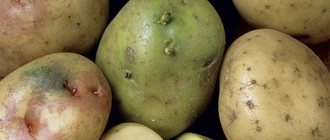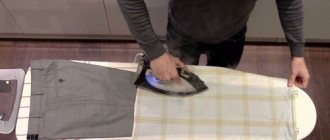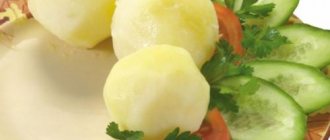Home/Articles/Soaking potatoes is an important step before cooking.
Potatoes are the most popular root vegetable. Since childhood, everyone knows that potatoes are the second bread. Most people grow it in their gardens, while others buy it in stores. This root vegetable is included in a huge number of dishes. Experienced chefs recommend soaking it before cooking. First of all, this applies to purchased potatoes. This article will tell you how and why to do this.
How to soak potatoes from starch || How to soak potatoes from starch
Access is limited by court decision or on other grounds established by the legislation of the Russian Federation.
A network address that allows you to identify a site on the Internet is included in the Unified Register of domain names, page indexes of Internet sites and network addresses that allow you to identify sites on the Internet containing information the distribution of which is prohibited in the Russian Federation.
A network address that allows you to identify a site on the Internet is included in the Register of domain names, indexes of pages of sites on the Internet and network addresses that allow you to identify sites on the Internet containing information distributed in violation of exclusive rights.
Boiled, fried or baked potatoes are forbidden fruit for many. But you can make the product less caloric and get rid of nitrates. To do this, you need to soak the potatoes so that the starch and other harmful components come out.
Why are potatoes soaked?
https://www..com/watch?v=ytadvertiseru
There is an opinion that potatoes consist mainly of water and starch. If the latter is eliminated, the tuber loses all nutritional value. This judgment is incorrect, since 100 g of the product contains:
- Silicon - 50 mg, or 170% of the daily value (DV). Thanks to the microelement, the skin becomes more elastic, blood vessels - elastic, hair and nails - strong.
- Boron - 115 mcg, or 164% s/n. By maintaining the required level of boron, bones will be strong, despite age-related changes. Women during menopause need boron to improve memory, relieve stress and prevent osteoporosis.
- Vanadium - 150 mcg, or 370% s/n. Normalizes cholesterol levels in the blood, takes part in redox processes in the body. Essential for athletes and people trying to lose weight.
- Rubidium - 500 mcg, or 500% s/n. The trace element helps strengthen the nervous system, has antihistamine properties, and increases blood pressure.
In addition to substances, the content of which in 100 g covers the daily needs of the human body, potatoes contain vitamins (B6, B9, C, PP, K), microelements (cobalt, lithium, manganese, chromium), omega-3.
Potatoes contain a lot of starch. Its volume is 15–17% of the mass. It is a polysaccharide that is converted into glucose in the stomach. People with diabetes or overweight, children, and people with allergies should avoid foods that increase blood sugar levels. If starch is eliminated, consumption of the product will become possible for them.
Nutritionists advise everyone, without exception, to soak potatoes before cooking, but there are people who are strictly forbidden to eat tubers without prior processing.
Soaking potatoes allows you to:
- Reduce the glycemic index (GI). This is important for diabetics. Products whose GI does not exceed 50 are allowed for consumption. In potatoes, the index reaches 70–80 (in sugar - 75), which makes the product completely unsuitable for citizens with a diagnosed disease. One could avoid potatoes altogether, but they contain many substances that support the patient’s body. The only way to introduce tuber dishes into the diet is to eliminate starch. After soaking, the GI drops by 25–30 units.
- Reduce the allergenicity of the product. Cases of negative reactions are rare, but if they are present, there is a high risk of allergies to other nightshades: eggplants, peppers, tomatoes. In adults, allergies have many manifestations: rash, symptoms of respiratory disease, swelling. Infants suffer from rashes and colic. Once a reaction is detected, consumption of potatoes should be stopped, and after 3-4 months, resumed, using only environmentally friendly soaked product. A nursing mother should also stop eating potatoes if her child shows signs of an allergy.
- Reduce calories. 100 g of starch contains approximately 357 calories. Potatoes are 83% pure fast carbohydrates that promote weight gain, and removing starch reduces calories.
- Remove nitrates. It has been proven that soaking allows you to get rid of growth stimulants that have a detrimental effect on humans.
For consumption, you need to select whole tubers without dents or signs of spoilage. You should pay attention to the color of the peel. If it is greenish, it means that the tuber has a high concentration of a toxic substance - solanine. Even in small quantities, it causes inflammation of the gastric mucosa, destroys red blood cells, and destabilizes the functioning of the nervous system.
After selecting high-quality tubers, you need to:
- Wash and peel the tubers, cut into several pieces. If the method of growing potatoes is known and the use of nitrates is excluded, you can cook potatoes in their jackets. It must be thoroughly washed and cut into 2-4 parts depending on the size of the potato.
- Pour in water until the liquid completely covers the contents of the container with tubers. Leave to wash out the starch for 60 minutes.
- Drain the water and repeat the process: pour in, leave for an hour. Afterwards, drain.
- Fill the tubers with clean water. Starch removal time is 12 hours. Afterwards, drain the water and prepare the dish.
We suggest you familiarize yourself with how and how to clean windows after renovation.
Cooking recommendations
If eating potatoes is not associated with the occurrence of negative reactions, you can eat them every day, but not more than 200 g. People with high blood sugar, gout and young children should limit their consumption to 100 g per week. Regardless of the cooking method, it is better to soak the potatoes.
To maintain the usefulness of the product and achieve the best taste, you can use the following tips:
- To prevent the skin of the tuber in its uniform from bursting, add a couple of drops of vinegar to the water.
- To speed up cooking, add a piece of butter (margarine) to the pan.
- To make the tubers lighter, you need to add 1 tsp during cooking. lemon juice.
- Purees should be eaten fresh. During heat treatment, it loses 30% of vitamin C, and when heated again, there will be no vitamins left in it.
- To obtain tasty and crumbly boiled potatoes, you need to pour salted boiling water over the soaked tubers.
- To minimize the amount of nitrates in store-bought potatoes, it is necessary to remove the skin in a thick layer. For an environmentally friendly product, another rule is to peel it as thinly as possible, and better yet, eat it with the peel, since it contains more vitamins than a peeled tuber.
- Frozen potatoes will lose their unpleasant taste if they are consumed no earlier than a week after storage at room temperature.
- Soaked potatoes are good to eat raw. It is recommended for cancer patients, people with increased swelling, metabolic disorders, and gum disease. Grated tubers can be mixed with apples and seasoned with lemon juice and honey. An important condition is the absence of pesticides.
Potatoes allow you to diversify your menu and saturate your body with useful microelements. If according to indications the tubers are prohibited from being eaten, soaking will correct the situation. Without starch and pesticides, potatoes are good for everyone.
Rule #1
We suggest you read: How to break in tight shoes at home
After peeling and slicing, potatoes must be soaked in cold water. The water must be cold in order to draw out the starch from the root vegetable.
If the water is hot or warm, the starch will remain in the root vegetables, and the finished dish will look more like stewed potatoes. Starch prevents the potatoes from browning, so you need to get rid of it by soaking. The younger the potatoes, the longer they should be soaked.
It's best if it takes 30 minutes or 1 hour.
Rule #2
After soaking, the potatoes must be thoroughly dried. It is better if you put the potatoes in a colander and then dry them on a paper towel. Regular linen will also work. The potatoes should be dry, because excess moisture will prevent the formation of a golden brown crust. And contact of water with hot fat can cause stains on your apron or kitchen utensils.
https://www..com/watch?v=ytpolicyandsafetyru
Rule #3
The pan should be hot and the oil should be heated. You shouldn’t skimp on the oil; the potatoes should be immersed in it well. Don't forget that many people's favorite French fries are fried in a lot of boiling oil.
Rule #4
Salt and add various spices only after the potatoes are ready. If you salt the potatoes during or before frying, it will release moisture, which will prevent the formation of a golden brown crust. Once the potatoes are cooked, use a slotted spoon to place them on a plate to drain off any excess oil. Then salt and add spices.
Rule #5
Never cover potatoes while frying. To obtain a golden brown and crispy crust, potatoes should be fried in an open frying pan.
Rule #6
https://www..com/watch?v=https:accounts.google.comServiceLogin
Don't put too many potatoes in the pan. Optimally 2-3 layers. No more. Tasty recommendations: Do you want to give your prepared potatoes a piquant aroma and taste? Then fry a few cloves of garlic in hot oil before cooking. Once it's browned, take it out and add the potatoes to fry.
soak, potatoes, starch
Source: https://uborka-52.ru/vymochit-kartofel-krakhmala/
Why do you soak potatoes before cooking?
There is hardly a person who does not know that potatoes contain a lot of starch, which is why people suffering from diabetes or overweight and allergy sufferers do not eat potato dishes. Potatoes without prior soaking should not be given to small children as complementary foods. People suffering from kidney disease and undergoing hemodialysis refuse potato dishes.
Nutritionists advise everyone, without exception, to soak potatoes before cooking, which allows:
- Reduce the glycemic index (GI). Diabetics know well what it is. They are allowed to eat foods whose GI does not exceed 50. In potatoes, the index reaches 70-80. After soaking potatoes, the GI immediately decreases by 25-30 units. By the way, in pink and purple potatoes the level of sugar and starch is 30% lower than in light varieties, so people with health problems are better off consuming these particular varieties of potatoes.
- Reduce calories. 100 g of starch contains approximately 357 calories, which contributes to rapid weight gain. Potatoes can easily be made less caloric by soaking them in cold water for a while.
- Pre-soaking potatoes allows you to get rid of nitrates and other chemicals. Agree that today few people eat organic potatoes; most often we use store-bought ones.
- Reduce the allergic properties of potatoes. Allergies from potato dishes can manifest themselves in both children and adults in the form of a rash, ARVI symptoms, and swelling.
Is there any point in soaking potatoes to remove nitrates?
What actually happens to potatoes when they are soaked in water? And who needs to do this?
Soaking vegetables is a simple and effective way to reduce nitrates. Up to 25 percent of these substances are concentrated on the surface of the peel.
Being water soluble, they dissolve into room temperature water within an hour, making the product safer. An even safer option is to cut off the peel to remove up to 80 percent of the hazardous substances if you plan to eat the vegetable fresh.
Or subject it to heat treatment: boil, stew, fry. In this case, there are no nitrates left in the vegetables at all.
Potatoes, unlike other vegetables, are not eaten fresh. Therefore, there is no point in soaking it to “remove harmful substances.” When boiling, baking and frying, nitrates are quickly destroyed; from this point of view, the root vegetable is absolutely safe. It is considered dubious for another reason - due to its high starch content.
When potatoes are boiled, nitrates are destroyed (Footage.framepool.com)
Risk of high blood glucose
Starches are a group of substances that, when digested in the body, turn into glucose. Potatoes of any type contain a lot of starch, which is why they are considered controversial products.
On the one hand, frequent consumption of potatoes increases the risk of diabetes, hypertension and obesity (this is confirmed by scientific research).
On the other hand, potatoes are a valuable source of potassium, the content of which surpasses other vegetables and even fruits.
It also contains polyphenols - biologically active substances that can resist cancer and reduce the harmful effects of free radicals.
And finally, potatoes are a tasty and affordable product. When other vegetables are significantly more expensive, people are more willing to buy potatoes, which they use to prepare hearty everyday meals.
Potatoes contain starch, potassium, polyphenols (Pixabay.com)
Soaking the potatoes before cooking allows you to find a balance between the harm of starch and the benefits of the biologically active substances of the root vegetable.
Potato soaking technique
During soaking, the starchy masses are partially washed out of the tubers. They come out of the root pulp and concentrate on the surface. The longer the tubers are in water, the more starch they lose. To get rid of starchy compounds, proceed as follows.
- Wash the potatoes, peel them or leave them in them.
- Cut the tubers into four parts.
- Fill with cold running water until it just covers the pieces.
- Leave for an hour, drain the water.
- Fill with water for another hour, drain, and rinse the potatoes.
When soaked, potatoes lose most of their starches (Kakxranit.ru)
There are especially a lot of starchy substances in last year's potatoes: during storage, the composition of the pulp changes. The root vegetable produces starches to provide nutrition to the sprouts. There is practically no starch in new potatoes, so there is no need to soak them.
Starch is not as harmful as it seems
Recently, nutritionists have recommended reconsidering our attitude towards starchy foods. Indeed, when they are consumed, blood sugar levels increase. But they satiate well and create a long-lasting feeling of satiety, which is useful for weight control and dieting, as it protects against sudden attacks of hunger.
In addition, the starches in vegetables and grains are different. Simple ones, which are found, for example, in boiled corn and mashed potatoes, are quickly broken down by the body into glucose.
But there are complex ones, the so-called resistant ones, they are found in cereal products and whole wheat pasta. With resistant starch, the body has to “tinker” and spend more energy on digestion.
Its breakdown takes a long time - over three to four hours, due to which the glucose level rises slowly and decreases just as slowly.
Mashed potatoes contain the most simple starch (Pixabay.com)
Resistant starch is good for the body. Products containing it do not cause a sharp increase in sugar levels and create a long-lasting feeling of satiety.
Potatoes can be a source of resistant starch even without soaking. To do this, you need to prepare it and put it in the refrigerator for 24 hours. In the cold, the structure of starchy compounds changes; the volume of substances resistant to breakdown increases fourfold.
So the healthiest potatoes are yesterday's potatoes, boiled or baked. When fried, starch is also converted into resistant starch, but the high fat content negates the benefits of the product.
Source: https://ura-povara.ru/journal/est-li-smysl-v-vymachivanii-kartoshki-chtoby-ubrat-nitraty/
How to reduce starch in potatoes
Not many people know whether people with diabetes can eat potatoes. Diabetics should be very careful when choosing their own diet. After all, eating the right foods can even slow down the progression of the disease.
When choosing certain products, diabetics should rely on what vitamins and microelements they contain. It is imperative to take into account the effect of a particular product on changes in blood sugar levels.
Action of carbohydrates
But sometimes disputes over the use of potatoes by diabetics still arise due to the special effect of carbohydrates on the patient’s body. Carbohydrates are divided into simple and complex:
- Simple. The human body absorbs this substance quite easily. After entering the blood, it begins to change the amount of sugar in it, increasing it.
- Complex (polysaccharides). They are absorbed much more slowly, and some of their components may not be accepted by the body. This element is found in corn, cereals, and potatoes. With abundant consumption of junk food, fat reserves increase in the human body, which is undesirable not only for diabetics, but also for people who do not have such a disease.
The human body, both healthy and sick, needs the right amount of carbohydrates in its daily menu. This useful component is found in fruits, legumes, vegetables, and also in cereals. But people diagnosed with diabetes should be extremely careful when consuming various foods, such as potatoes.
Can you eat potatoes if you have diabetes?
Regarding whether people with diabetes can eat potatoes, the opinion of experts is unanimous - this vegetable is allowed to be eaten, but in small quantities.
In general, potatoes are a very healthy food product that contains a lot of different vitamins. However, it contains a significant amount of polysaccharides, so diabetics should introduce it into the daily menu with extreme caution (about 250 g per day).
But in addition to calculating the amount of potatoes, they must be prepared in certain ways. Nutritionists say that the method of preparing this vegetable has a direct impact on the patient’s well-being.
Since diabetes mellitus is often accompanied by disruptions occurring in the digestive system, experts recommend that diabetics always adhere to the rules regarding food preparation.
How to reduce the carbohydrate content in potatoes?
Soaking potatoes significantly reduces their starch content. In addition, this process has a beneficial effect on the digestive system. To reduce the amount of starch in potatoes, the peeled vegetable must be rinsed under running water.
Soaked tubers will improve digestion, and the stomach will stop producing a substance that increases blood sugar. Soaking is done as follows:
- The vegetable is peeled and then thoroughly washed.
- It is placed in a dish (saucepan, bowl) and filled with cool water.
- Potatoes are soaked in cold water for about 11 hours.
During this time, most of the starch and other elements that are undesirable and even harmful for people with diabetes will be released from the potatoes. For greater health benefits, it is better to steam waxes processed in this way.
What are the best ways to cook potatoes for diabetics?
In uniform. For people suffering from diabetes, it is most beneficial to eat boiled potatoes in their jackets.
Fried. Fried potatoes and chips cooked in vegetable oil are allowed in minimal quantities. But it’s better not to eat potatoes fried in animal fat at all.
- Baked potato. If you have type 2 diabetes, it is useful to eat baked potatoes, which can be cooked either in the oven or in a slow cooker. But it is not advisable to eat baked potatoes on their own. It is better to add a side dish to this dish, for example, a salad of fresh vegetables. You should also know that one medium baked potato contains 145 calories. This should be taken into account when creating a diet for diabetics. It is also recommended to constantly include this baked vegetable in the menu as a preventive measure for heart and vascular diseases.
- Boiled. This cooking option is best for diabetics. A standard serving of boiled potatoes contains approximately 114 calories. Such a dish has the same effect on the change in sugar content as fruit juices without sugar and whole grain bread with bran.
- Puree. People suffering from diabetes should not eat crushed boiled potatoes. Interestingly, mashed potatoes significantly increase glucose levels, just like sweets or Coca-Cola. In particular, sugar increases if the dish is cooked in oil rather than water.
Source: https://doc-diabet.com/diabet/kak-umenshit-krahmal-v-kartofele.html
Why soak potatoes - Delicious!
Life without potatoes is not life. Imagine how many amazing dishes we would lose if potatoes were removed from cooking! Unfortunately, fewer and fewer people grow their own crops and more and more people buy this delicious product in stores. However, the quality of such potatoes leaves much to be desired...
Experts recommend that all purchased potatoes be soaked in water before cooking. These recommendations especially apply to people with allergies, diabetics and young children. Why do you need to soak potatoes , what is the reason for this and how to do it correctly, find out from this article.
Why soak potatoes?
Tubers should be soaked for the following reasons:
- As you know, potatoes are a starchy vegetable , and starch is a strong allergen. There is especially a lot of starch in new potatoes. This polysaccharide is converted into glucose in the stomach, which increases blood sugar levels . For people who are overweight and have diabetes, this reaction can cause a lot of suffering.
- Starch feeds pathogenic flora in the intestines, such as candida fungus , which often leads to constipation or diarrhea. Soaking potatoes allows you to get rid of most of the starch, remove nitrates, and make the product less high in calories and more healthy. At the same time, the organoleptic characteristics of the product are improved: after cooking, mashed potatoes become airy and not paste-like.
- For people suffering from kidney disease and undergoing hemodialysis, eating potatoes that have not been pre-soaked is strictly contraindicated. Elevated levels of potassium in the body (hyperkalemia) can be dangerous to health and life.
How and how long to soak potatoes?
- Clean the tubers from stains and completely remove problem areas. green potatoes immediately, as they contain the toxic substance solanine, which even in small quantities causes inflammation of the stomach mucosa, destroys blood cells and disrupts the functioning of the nervous system.
- Remove the peel, wash, cut the vegetable into cubes, and cover with warm water for at least 2 hours. The liquid should completely cover the contents.
- Then change the water and repeat the process.
Fill with water again, adding a little salt and ascorbic acid. If you are using homemade potatoes and you are sure that no nitrates were used when growing them, then you can cook potatoes in their jackets. - The finer you cut the potatoes (for example, grate them), the faster the starch will release.
If you plan to cook the whole tubers, it is better to fill the potatoes with clean water in advance and leave them overnight, since the starch removal time is 12 hours.
How to cook potatoes properly
In starchy plant foods, which include potatoes, when heated above 120 degrees, acrylamide - a dangerous carcinogen that leads to hormonal imbalances, cell mutations and cancer in animals and people. The substance is created by a chemical reaction when you fry or bake potatoes. Therefore, it is preferable to steam, stew or boil the vegetable.
However, there is good news for chips and french fries lovers! Scientists published the results of a study in the journal Science of Food and Agriculture, which showed that pre-soaking potatoes in water reduced acrylamide concentrations by 48%. Provided that the product is cooked until it turns light golden brown and not brown.
In any case, potatoes must be soaked before cooking. To maintain the benefits and improve the taste of the product, follow a few tips:
- When you boil jacket potatoes, add 1 tsp to the water. vinegar or lemon juice to prevent the peel from bursting.
- The vegetable will cook faster if you add a piece of butter or margarine to the pan.
- Cook the puree as much as you eat at a time: during heat treatment, a third of the vitamins are lost, and when reheated, none remain at all.
- To reduce nitrate levels in store-bought potatoes, cut off the skins in thick layers. Homemade potatoes are the opposite - peel them as thinly as possible and eat with the skins on.
- Frozen potatoes will become tasty again if you keep them at room temperature for a week.
- Soaked potatoes are healthy even when eaten raw. Make it into a salad with apple, lemon juice and honey. It is recommended for cancer patients, metabolic disorders, gum disease and increased swelling.
Surprisingly, you can successfully lose weight on a potato diet, as confirmed by the experience of Australian Andrew Taylor. If you have no contraindications to consuming this product, then you can eat it every day, but not more than 200 g. People with high blood sugar, gout and small children should reduce potato portions to 100 g per week.
Source: https://vkusnoinfo.ru/zachem-vymachivat-kartofel/
What are starchy potatoes used for?
As mentioned above, starchy potato varieties are used for dishes where complete boiling of the tubers is necessary. They are also used for the production of starch.
Important! The less fertilizer is used when growing potatoes, the more polysaccharide there is in the tubers.
Starchy vegetables are indispensable in cases where you need to get enough of less potatoes.
High-starch varieties are divided into several varieties according to their intended purpose:
- Universal potatoes are equally suitable for both food consumption and the production of starch and other substances.
- Food potatoes are grown in the largest quantities, as they are used for sale. The rate of starch in such tubers corresponds to GOST.
- Industrial potatoes are used for the production of alcohols and starch, and animal feeding.
- Fodder potatoes are distinguished by an increased percentage of not only starch, but also protein in their composition, which distinguishes them favorably from technical potatoes.
If you soak potatoes in cold water
Boiled, fried or baked potatoes are forbidden fruit for many. But you can make the product less caloric and get rid of nitrates. To do this, you need to soak the potatoes so that the starch and other harmful components come out.
Are soaked potatoes healthy?
There is an opinion that potatoes consist mainly of water and starch. If the latter is eliminated, the tuber loses all nutritional value. This judgment is incorrect, since 100 g of the product contains:
- Silicon - 50 mg, or 170% of the daily value (DV). Thanks to the microelement, the skin becomes more elastic, blood vessels - elastic, hair and nails - strong.
- Boron - 115 mcg, or 164% s/n. By maintaining the required level of boron, bones will be strong, despite age-related changes. Women during menopause need boron to improve memory, relieve stress and prevent osteoporosis.
- Vanadium - 150 mcg, or 370% s/n. Normalizes cholesterol levels in the blood, takes part in redox processes in the body. Essential for athletes and people trying to lose weight.
- Rubidium - 500 mcg, or 500% s/n. The trace element helps strengthen the nervous system, has antihistamine properties, and increases blood pressure.
In addition to substances, the content of which in 100 g covers the daily needs of the human body, potatoes contain vitamins (B6, B9, C, PP, K), microelements (cobalt, lithium, manganese, chromium), omega-3.
Potatoes contain a lot of starch. Its volume is 15–17% of the mass. It is a polysaccharide that is converted into glucose in the stomach. People with diabetes or overweight, children, and people with allergies should avoid foods that increase blood sugar levels. If starch is eliminated, consumption of the product will become possible for them.
How to soak potatoes before cooking?
For consumption, you need to select whole tubers without dents or signs of spoilage. You should pay attention to the color of the peel. If it is greenish, it means that the tuber has a high concentration of a toxic substance - solanine. Even in small quantities, it causes inflammation of the gastric mucosa, destroys red blood cells, and destabilizes the functioning of the nervous system.
After selecting high-quality tubers, you need to:
- Wash and peel the tubers, cut into several pieces. If the method of growing potatoes is known and the use of nitrates is excluded, you can cook potatoes in their jackets. It must be thoroughly washed and cut into 2-4 parts depending on the size of the potato.
- Pour in water until the liquid completely covers the contents of the container with tubers. Leave to wash out the starch for 60 minutes.
- Drain the water and repeat the process: pour in, leave for an hour. Afterwards, drain.
- Fill the tubers with clean water. Starch removal time is 12 hours. Afterwards, drain the water and prepare the dish.
The smaller the potatoes are cut before soaking, the easier the starch will come out of them. The processing time can be reduced by 4 times if you grate the tubers on a coarse grater before the procedure.
How to soak potatoes correctly?
For consumption, you should choose only good tubers, without any damage. The green color of the peel indicates that the tuber contains selanine, a very toxic substance. Consuming it even in small quantities can cause irritation of the gastric mucosa.
After the potatoes have been selected with high quality, they must be peeled. Then rinse thoroughly, cut into cubes and cover with water at room temperature for about 2 hours. The water should completely cover the potatoes. Sliced potatoes will release starch faster.
After the time has elapsed, drain the water in which the root crop was contained and refill with fresh water. Leave it for another hour.
Next, drain the water again and refill with fresh water. It takes 12 hours to completely remove starch. After this, the potatoes are ready for cooking.
If you do not cut the potatoes into cubes, but soak them whole, then the soaking time needs to be increased. You can leave the soaked root vegetables overnight.










